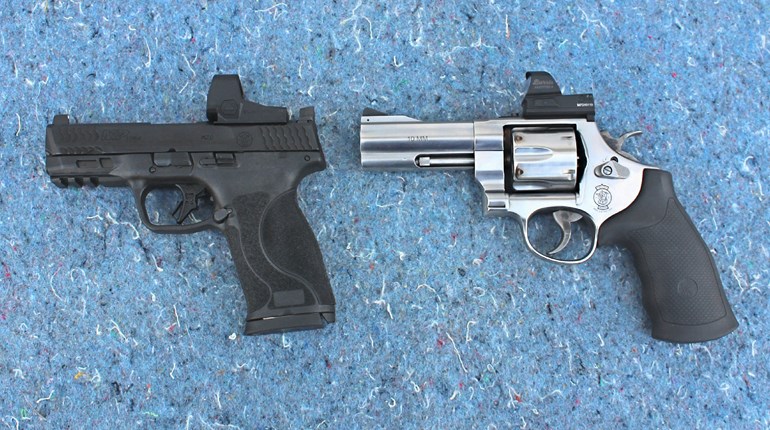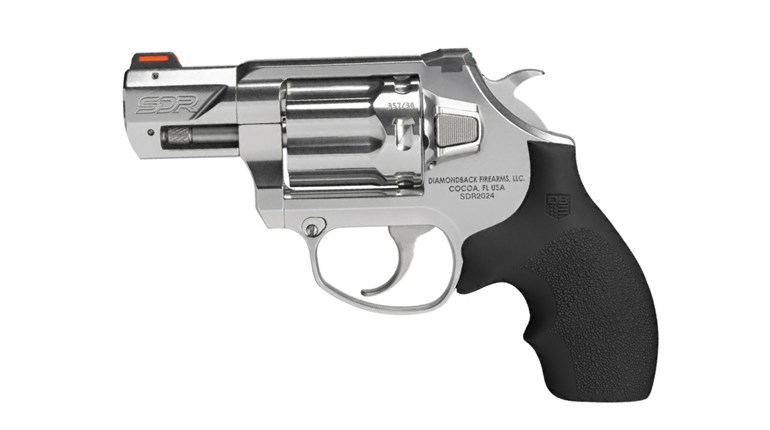
A few years ago we posted a discussion about whether or not .22 LR pistols made sense for self defense. It's garnered enough attention to remain in the top six most popular articles on the site. It's about time that we follow up with a conversation about another commonly asked question: Do .22 LR rifles make sense for home defense? First, let's take a look at how .22 LR rifles compare to .22-caliber pistols. Then we'll size them up against center-fire handguns and carbines.
The Ever Popular .22 LR Rifle
Long guns chambered for the diminutive .22 LR cartridge are among the most popular firearms in the United States and have been for decades. The .22 LR cartridge is one of the least expensive options available and produces low levels of felt recoil. Rimfires are available with a wide variety of features and price points. They are ideal for training new shooters, casual plinking, small game hunting and you'll find models that have been gussied up for formal target shooting competitions. In fact, for many shooting sports enthusiasts (myself included) their earliest shooting experiences, and the first guns they've owned, have been .22-cal. rifles.

Budget-friendly wood-stocked .22 LR carbines like the Marlin 60 have been a mainstay of American shooting sports for decades.
Several of the long guns available chambered for .22 LR are carbines. This means they are compact, light-weight guns with barrels around 16" in length. An 18" barrel is a mid-length option while guns with barrels 20" or longer are called 'rifles.' For this conversation I'm going to focus on .22 LR carbines when discussing performance information since they are among the most common options available.
.22 LR Rifles vs. .22 LR Pistols
In regard to magazine capacity, whether a given .22 rifle holds more ammunition than a rimfire pistol depends on the model in question. Single-stack pistols usually accept 10- or 12-round magazines while double-stack pistols, which are relatively new to the shooting market, use 16- to 20-round magazines. Lever-actions and semi-automatic rifles fitted with tubular magazines hold around 14- to 16-shots. Semi-automatic rifles that take removable box magazines can have capacities of anywhere from 5- to 25-rounds depending on the gun. Some rifle models, like the Ruger 10/22, can accept more specialized magazines with capacities of 30-rounds or more. Regardless of their capacity, it's a good idea to stage a spare magazine or two just in case the magazine itself jams, breaks or gets dropped.

Modern rimfire carbines, like the Winchester wildcat, are loaded with cutting edge features including light-weight polymer stocks, threaded barrels and optics-ready receivers.
Semi-automatic pistols chambered for .22 LR tend to be more ammunition sensitive than just about any other type of firearm available. There are plenty of loads which will operate properly in a variety of pistols. But it can take a bit more foot work to find the loads which work best in a particular rimfire handgun.
However, as the cartridge name implies, the .22 LR (Long Rifle), was designed for use in rifles. A longer barrel gives the powder charge more time to burn properly and to develop an optimal level of pressure. The bullet will leave the barrel traveling faster and, for semi-automatic rifles, there will be enough pressure generated to cycle the action reliably. As a result, most .22 LR rifles do not suffer from the same levels of ammunition sensitivity as pistols. This means they will operate reliably with a broader range of bullet weights and velocities than pistols.

The tubular magazines of old fashioned lever-actions can hold a good deal of ammunition. The Henry American Beauty shown here holds up to 16 rounds of .22 LR or 21 rounds of .22 Short.
In most cases, rifle-length firearms can produce tighter shot patterns than pistol-size guns. This allows them to shoot more accurately at longer distances. A well-tuned target rifle will shoot smaller groups at 50 to 100 yards than a well-made pistol can print at 25 yards. This makes .22 rifles more flexible for other shooting endeavors. And more time spent using the gun in the field contributes to better developed shooting skills and familiarity with the gun's controls.

A .22-cal. hollow point bullet is more likely to expand properly when fired from a rifle length barrel.
Simply stated, most .22-cal. rifles are going to outperform rimfire pistols when firing the same ammunition. But just how much of a performance boost do rifles provide for home defense? At across-the-room defensive distances, pistols and rifles are on a level playing field when it comes to accuracy.
That brings us to bullet energy. Longer rifle barrels can hit harder than pistol-length barrels and hollow-point bullets are more likely to expand properly when fired from a longer gun. But bullet energy depends as much on the ammunition used as the gun it’s fired from. Take a look at the following list. It shows the muzzle energy range of a short-barrel revolver, a pistol and two rifles that I've chronographed:
Caliber Firearm Muzzle Energy Reference
.22 LR 3" Revolver 76 to 82 ft.-lbs. (Ruger Wrangler)
.22 LR 4" Pistol 79 to 113 ft.-lbs. (Taurus TX22)
.22 LR 16" Carbine 105 to 147 ft.-lbs. (Winchester Wildcat)
.22 LR 18" Target Rifle 87 to 99 ft.-lbs. (Ruger Precision)
The first three guns on the list were fired using high-velocity .22 LR loads topped with 36-gr. to 40-gr. bullets. As the barrel lengths increase, so does bullet energy. However, there is an overlap between the 4" pistol and the 16" carbine where the energy levels are similar, depending on the load fired. The fourth rifle on the list was tested with low velocity loads designed specifically for target shooting. Despite having the longest barrel on the list, this rifle's energy output is in the same range as the 4" pistol because of the ammunition set used for testing. This is why it’s important to pay attention to the specifications of the ammunition when making a purchase.
.22 LR Rifles vs. Centerfire Handguns & Rifles
In the write-up about .22 LR pistols, a good deal of the conversation dealt with the reliability issues which are inherent in rimfire cartridge design. No matter which platform you use, rifle or pistol, .22 LR cartridges are more likely to fail to fire due to faulty primers than centerfire rifle or pistol cartridges.

Check .22 LR ammunition boxes for listed rifle velocities. Subsonic loads have been slowed down for use with sound suppressors. Look for high-velocity loads like those in the 2nd and 3rd boxes.
Rifles chambered in .22 LR also tend to run dirty. This is due in part to the types of powders used. But most of the commercially available .22 LR ammunition currently available is topped off with bullets that are coated with a waxy lubricate. This wax helps the bullet to travel more smoothly down and out of the bore but it also leaves behind a greasy residue that can gum up the rifle's works over time. This lubricant works well enough that most rifles can fire hundreds of rounds before they need to be cleaned. Nevertheless, a dirty .22 is more likely to jam at an inconvenient moment.

Test your magazines along with the ammunition. Stage additional loaded magazines with your rifle when possible.
When it comes to bullet energy, the vast majority of center-fire handguns and rifles are going to outperform a .22 LR rifle at close range. Bullets that strike with higher levels of energy, which is measured in foot pounds of pressure (ft.-lbs.) are more likely to end a confrontation quickly with fewer shots fired. The sooner the fight is over, the less likely it is that the home defender will be injured. And fewer bullets leaving the gun will reduce the potential for unintended collateral damage. Like .22 LR pistols, rimfire rifles are more likely to required additional shots to be fired in order to stop an assailant intent on doing harm.
Caliber Firearm Muzzle Energy Reference
.45 ACP 5" Pistol 360 to 434 ft.-lbs. (Girsan MC1911 ME)
9 mm 4" Pistol 282 to 355 ft.-lbs. (Ruger Security-9)
.380 ACP 3.54" Pistol 140 to 180 ft.-lbs. (Walther CCP M22)
.22 LR 4" Pistol 79 to 113 ft.-lbs. (Taurus TX22)
.22 LR 16" Carbine 105 to 147 ft.-lbs. (Winchester Wildcat)
9 mm 16.1" Carbine 496 to 560 ft.-lbs. (Ruger PCC)
.223 Rem. 16.31" Carbine 1,125 to 1,227ft.-lbs. (RISE Watchman)
.308 Win. 16" Carbine 2,414 to 2,451 ft.-lbs. (Sig Sauer 716i Tread)
Does a .22 LR Rifle Make Sense for Self-Defense?
Years ago, in another write-up, I wrote what I'm going to say here: Rifles chambered for .22 LR are not an optimal choice for personal protection. They simply do not deliver the same levels of performance potential as centerfire handguns and carbines. But this time I would like to add a caveat: Rimfires are not optimal but they should not be dismissed out of hand as defensive tools in a pinch.

A takedown rifle like the Henry U.S. Survival may be the only gun at hand when an emergency situation arises.
That previous article inspired a heartfelt response from a parent in which they shared the story of their college-age son. He survived a brazen day-time home invasion thanks to the trusty Ruger 10/22 rifle he learned to shoot with as a boy. He took the 10/22 when he left home for school so that he could use it for target shooting on the weekends. No less than four assailants illegally entered his apartment that day but they felt 'inspired' to exit post haste when they realized that one of the occupants was armed and prepared to defend himself.

The Ruger 10/22, and its many clones, are among the most popular semi-automatic rimfire carbines available. The Magnum Research Switchbolt shown here has a reversible bolt handle for right- or left-handed shooters.
Did the 10/22 successfully fill the role of a defensive firearm in this situation? It most certainly did. And this is not a unique situation. I've heard and read more than a few first-hand accounts of individuals caught in sticky situations in which a .22 LR rifle or pistol preserved their lives. It was the only gun they owned, it was the gun at hand at that time or they were limited to rimfire levels of felt recoil due to their physical limitations.
The same advice mentioned in previous "whatchagot" self-defense conversations should be applied here. If a .22 LR rifle is going to be staged as a primary or secondary defensive gun, then make sure it is in good working order. Clean it thoroughly and lubricate it properly before staging it. Stoke it with premium-grade, high-velocity ammunition that you've tested and stage extra loaded magazines or ammunition with the gun. When you’re in a better position to arm yourself with a more potent defensive option, do so. Until then, make the most of what’s at hand.
















































